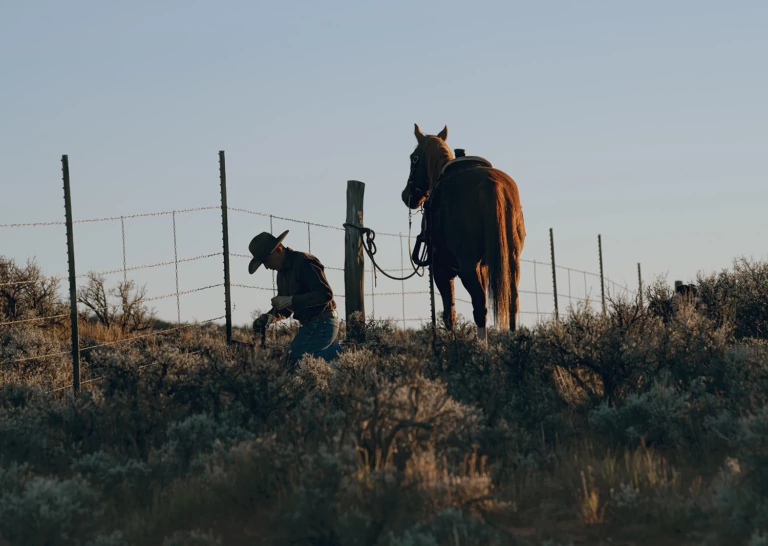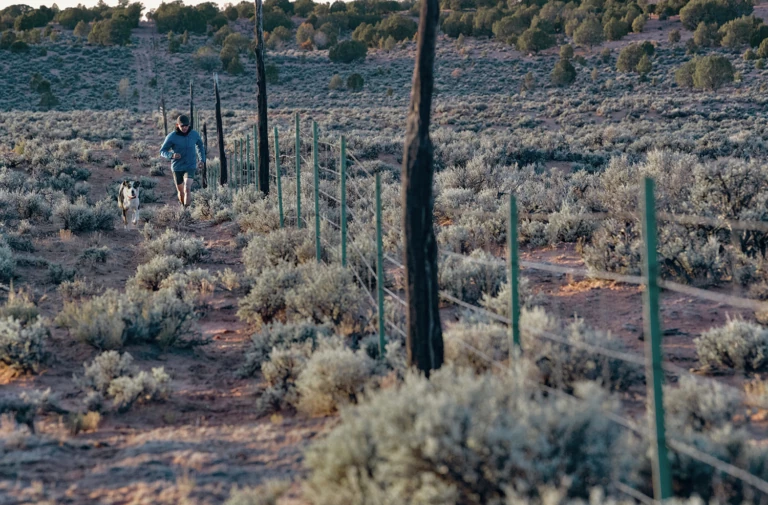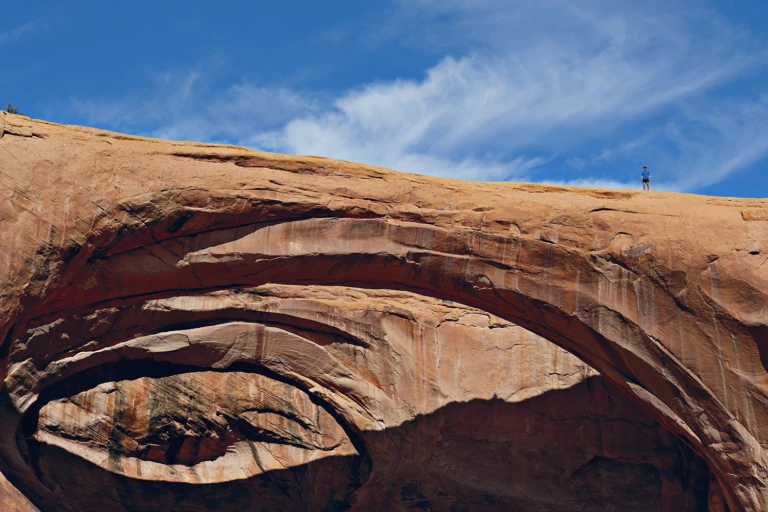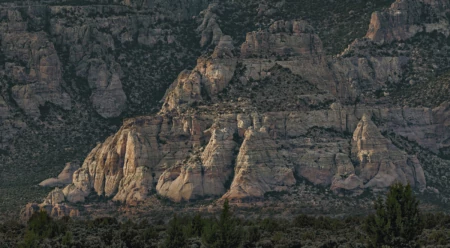Why Run
Generations of a Diné family reflect on running.
Some time in the northern corner of the Diné reservation helps clarify why this question is so hard to answer.
A girl wakes and runs toward the light, her dark hair streaming behind her as she races in the direction of the rising sun. She hears the prayers of her family and friends as her small feet skim the soft earth and red-hued dirt gathers in the hollows below her ankle bones. The farther she runs, the longer she will live, at least that’s what she is told. And so she runs as far as she can while filigrees of fire-colored dawn illuminate the sandstone ziggurats in the distance. Today, she isn’t a girl anymore.
It’s impossible to write about running without getting something wrong. Nothing quite captures the communal solitude and ecstatic suffering in a way that neatly transposes onto another’s experience. Sometimes there’s escapism, dispensation, confrontation. Sometimes uncontained exhilaration. Sometimes it’s routine. Runners get asked all the time why they run, but this is precisely the reason it’s so complicated: There can be a million reasons compressed into a single step, and the person asking you will never fully understand because you don’t either. Sometimes it’s just a run.
Kathy Neztsosie remembers the mornings when her grandfather would wake her and her siblings and cousins at 4 a.m. to run. “It was still dark. Sometimes he would splash us with cold water if we refused to get up,” she says, looking out toward the northeastern border of the Diné reservation, the twin buttes of Bears Ears just barely visible in the distance. She’s in a green hoody pulled up over her ears and zipped to the chin, and matter-of-fact. “My siblings, cousins, we’d all go running. I learned later in life that my grandfather was trying to teach us discipline. He wanted us to have a strong heart and mind.”
After she got married, Kathy moved north to Navajo Mountain, which straddles the border between Utah and Arizona, nearly 90 miles driving distance to the nearest grocery store. Few of the properties have electricity or running water. There is a school, but only because a group of students and parents sued San Juan County and Utah officials in 1974 for equal access to education. The mountain, which is also known as Naatsis’áán, rises to an inconclusive point over twisting, cross-bedded canyons, where herds of sheep and cattle graze. The 10,388-foot peak is a laccolith, formed by an injection of magma between sedimentary rock that forces the strata above into a domelike shape.

Mending fences on horseback. Photo: Ace Kvale
In 1864 a group of Diné hid in the maze of canyons formed by erosion, while the other members of their tribe were force-marched to the Bosque Redondo in what is now known as The Long Walk. Last year, to commemorate the 150th anniversary of the end of their exile, a handful of runners traversed a 400-mile route in stages.
The stars are wild out here. In Fire in the Mind, a strange book about physics and spirituality set in New Mexico, Black God arranged constellations of star crystals in the sky and lit them on fire. But before he was done, Coyote stole the rest and scattered them with abandon.
The Neztsosie family’s ranch is technically in Arizona, but all of the Navajo reservation stays on the same time zone as Utah, which really only means that your cellphone will often switch from one hour to the next, simply by walking a few feet in any direction. Lake Powell is over the border to the northwest. It’s Hayduke country, Zane Grey country. Wild, rugged, thankless, take-your-breath-away beautiful country.
This is where Kathy and her husband raised their children. Their son, Eli, now manages most of the family’s land. He also runs.

Eli (and his running partner, Tractor) checks the fences on a run around the ranch. Photo: Ace Kvale
A boy wakes and runs for the bus, sprinting over the uneven surface of his family’s land. He passes the cows, leaps over berms and reaches the highway just in time to intercept the yellow bus that will take him to school. He has a different purpose. That’s what his mother says. But he’s still a boy. Running isn’t intentional; it’s just necessary.
The Diné have dozens of ceremonies associated with running, and yet asking someone to tell you the stories or explain the significance of the ceremonies is like finding someone to explain the origins of the universe. There is too much that is incomplete, too much variation, and everyone believes something slightly different.
In his 1981 book, Indian Running, Peter Nabokov observes that to the Diné, “running meant joining in the emotion which is at the heart of life itself … everything from Navajo settlement patterns to healing rituals contains the motif of ceaseless motion.” One Diné story tells of a frog runner urinating on a track to blind or bewitch his opponent during a race; another is the story of the twins Morning Star and Evening Star, who organized a race in order to allocate the distribution of corn to the Zuni, Acoma and Diné. They each offered their fastest men, and Morning Star broke the corn into three pieces. The Diné finished first, the Acoma the middle, and the Zuni the end. “Morning Star was concerned,” goes the story recorded in Nabokov’s book, “but his brother reassured him. ‘It is well. The Navajo is the swiftest runner.

Eli traverses a natural sandstone arch near the family’s ranch. Photo: Ace Kvale
He will always be moving from place to place. He will not be able to take care of much corn.’ So it is today that the Navajo, unlike stationary Pueblos, are ever shifting between their summer and winter homesteads.”
When Kathy reached puberty, she took part in a kinaalda ceremony for young girls, based on the story of Changing Woman. As part of her celebration ceremony, she was instructed to run as far as she could and then to return. This is supposed to make a girl strong in both body and soul. Kathy remembers waking early every day for four days and running toward the rising sun. Her hair was braided, a corn cake was baked and the elders showed her the way. “I don’t remember the significance of it all,” she said. “I’ll ask my mother.”
For Eli, running isn’t about the stories he doesn’t care to interpret. He wants running to be about running. It’s economical, practical and grounding. “I’m not going to give my version [of a story or ceremony] and find out it’s wrong,” he says. “It’s like someone asking me, what’s the square root of 9.5 and me coming up with some random answer without doing my research or writing it down.” Running for him is a closer parallel to the work he’s done his whole life. “Growing up as a rancher prepared me for running,” he says, sitting by the wood stove in his grandparent’s hogan. “It taught me to never give up, whether it’s 0 degrees outside or 100. It’s midnight and you haven’t slept in two days, but you still have a job to get done.” He’s read The Art of War at least two times cover to cover, which he says has enhanced his sense of strategy and discipline. ”Every single day you’ve got to be out there putting in miles, even the days you feel lazy. That’s the day that discipline matters most.”
Like Eli, other Diné admit frustration when trying to explain that running isn’t always a spiritual practice. “Every few years someone comes along and tries to write a story about Navajo runners,” says Dustin Martin, executive director of Wings of America—a program based in Santa Fe that promotes running and youth leadership. “We’re just runners. And we’ve proved we can be competitive at very high levels.” He wants to see running as the proof point that the Diné are doing “just fine.”
A man wakes and ties his shoes—the sun just clearing the horizon line. He has work to do. But first he will run, feeling the familiar ground beneath his feet, the patterns and contours of the ranch roads and trails of his home. He pursues the discipline that running requires.
If he missed the bus as a kid, Eli would run the entire way from his family’s property to the highway to catch up to it. As an adult, instead of driving the pickup truck he rebuilt, he started running from one cow gate to the next, a 15-mile circumnavigation of his family’s ranch, just to be sure the cows didn’t stray. “Things come into my life because of necessity,” he says, glancing out the window at the rising moon. “I needed something done, there was no one to do it.”
Even so, it’s more metaphorical than that. He finishes the thought by saying, “Running is about chasing after what you want in life. If you don’t have a clear vision or a clear goal, you’re kind of just wandering around aimlessly. You can have the best truck in the world, but if you have no destination you’re just going to be driving around in circles.”

